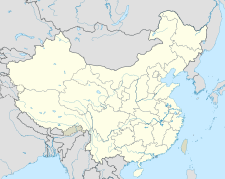Yanbeilong
| Yanbeilong Temporal range: Early Cretaceous,
| |
|---|---|

| |
| Speculative reconstruction | |
| Scientific classification | |
| Domain: | Eukaryota |
| Kingdom: | Animalia |
| Phylum: | Chordata |
| Clade: | Dinosauria |
| Clade: | †Ornithischia |
| Clade: | †Thyreophora |
| Clade: | †Stegosauria |
| Genus: | †Yanbeilong Jia et al., 2024 |
| Species: | †Y. ultimus
|
| Binomial name | |
| †Yanbeilong ultimus Jia et al., 2024
| |
Yanbeilong (meaning "north of Yanmen Pass dragon") is an extinct genus of stegosaurian dinosaur from the Early Cretaceous (Albian) Zuoyun Formation of Shanxi, China. The type and only species is Y. ultimus. It is considered one of the youngest definitive records of the group, alongside Mongolostegus from Mongolia and possible Stegosaurus remains from the Hekou Group of China, both of which date to the Aptian–Albian.[1][2][3]
Discovery and naming[edit]
The Yanbeilong holotype specimen, SXMG V 00006, was discovered in 2011 in sediments of the Zuoyun Formation near Madaotou Township in Zuoyun County of Datong City, Shanxi Province, China.[4] The specimen consists of the sacrum, both ilia, the left ischium, right pubis, seven dorsal vertebrae (two of which were isolated, the other five found in association with the ilio-sacral block), and a caudal vertebra.[1]
In 2024, Jia et al. described Yanbeilong ultimus as a new genus and species of stegosaur based on these fossil remains. The generic name, "Yanbeilong", combines the Chinese "Yanbei", meaning "North of Yanmen Pass"—referencing the general area of the type locality—and "long", meaning "dragon". The specific name, "ultimus", is a Latin word meaning "last", referencing the fact that this taxon represents a late-surviving member of the stegosaur lineage.[1]
Classification[edit]
Jia et al. (2024) recovered Yanbeilong as a deeply-nested member of the Stegosauria, as the sister taxon to a clade containing Stegosaurus stenops and Wuerhosaurus. The results of their phylogenetic analyses are shown in the cladogram below:[1]
References[edit]
- ^ a b c d Jia, Lei; Li, Ning; Dong, Liyang; Shi, Jianru; Kang, Zhishuai; Wang, Suozhu; Xu, Shichao; You, Hailu (2024-01-31). "A new stegosaur from the late Early Cretaceous of Zuoyun, Shanxi Province, China". Historical Biology: 1–10. doi:10.1080/08912963.2024.2308214. ISSN 0891-2963.
- ^ Tumanova, T. A.; Alifanov, V. R. (2018-12-01). "First Record of Stegosaur (Ornithischia, Dinosauria) from the Aptian–Albian of Mongolia". Paleontological Journal. 52 (14): 1771–1779. Bibcode:2018PalJ...52.1771T. doi:10.1134/S0031030118140186. ISSN 1555-6174. S2CID 91559457.
- ^ Li, Ning; Li, Daqing; Peng, Guangzhao; You, Hailu (2024). "The first stegosaurian dinosaur from Gansu Province, China". Cretaceous Research. 158 (in press). 105852. Bibcode:2024CrRes.15805852L. doi:10.1016/j.cretres.2024.105852. S2CID 267286799.
- ^ Dong, Liyang; Yi, Jian; Liu, Yingchao; Xu, Shichao; Wang, Suozhu; Zhang, Cai (2018-03-24). "山西左云地区下白垩统左云组沉积相及其古气候意义" [Sedimentary Facies of Lower Cretaceous Zuoyun Formation and Paleoclimate of Early Cretaceous]. Geological Review (in Chinese). 64 (2): 392–404. doi:10.16509/j.georeview.2018.02.007. ISSN 0371-5736.


